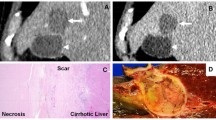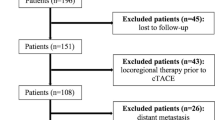Abstract
To correlate posttreatment radiologic and pathologic findings in patients who underwent transarterial chemoembolization before transplantation or resection. Thirty-five patients with postchemoembolization follow-up imaging underwent liver transplantation/resection. Pre- and posttreatment contrast-enhanced magnetic resonance imaging were used to evaluate radiologic findings. Imaging characteristics using World Health Organization (WHO) and European Association for the Study of the Liver (EASL) criteria after treatment were evaluated. Treated lesions were examined by pathology (gold standard) for the assessment of necrosis. Radiologic findings on magnetic resonance imaging were correlated to pathologic findings to assess the predictability by imaging of actual necrosis. Kappa (κ) statistics were used to determine intermethod agreement between WHO and EASL criteria. Fourteen (40%) of 35 lesions had biopsy-proven hepatocellular carcinoma. Thirteen (37%) of 35 target lesions showed complete pathologic necrosis. Complete pathologic necrosis was seen in 35% of lesions with pretreatment size <3 cm. Complete pathologic necrosis was seen in 1 (100%) of 1, 6 (67%) of 9, 6 (33%) of 18, and 0 (0%) of 7 of the lesions that exhibited complete response (CR), partial response (PR), stable disease (SD), or progressive disease (PD) by WHO criteria, respectively. Complete pathologic necrosis was seen in 9 (82%) of 11, 4 (36%) of 11, 0 (0%) of 8, and 0 (0%) of 5 of the lesions that showed CR, PR, SD, or PD by EASL criteria, respectively. EASL CR and WHO response were shown to have ≥85% specificity for predicting complete pathologic necrosis. The κ coefficient for agreement between WHO and EASL was 0.29. EASL and WHO criteria had minimal intermethod agreement. EASL CR and WHO response were able to predict pathologic necrosis.



Similar content being viewed by others
References
El-Serag HB (2002) Hepatocellular carcinoma and hepatitis C in the United States. Hepatology 36(5 suppl 1):S74–S83
Mazzaferro V, Regalia E, Doci R et al (1996) Liver transplantation for the treatment of small hepatocellular carcinomas in patients with cirrhosis. N Engl J Med 334:693–699
Maddala YK, Stadheim L, Andrews JC et al (2004) Drop-out rates of patients with hepatocellular cancer listed for liver transplantation: outcome with chemoembolization. Liver Transpl 10:449–455
Kulik LM, Atassi B, van Holsbeeck L et al (2006) Yttrium-90 microspheres (TheraSphere(R)) treatment of unresectable hepatocellular carcinoma: downstaging to resection, RFA and bridge to transplantation. J Surg Oncol 94:572–586
Lu DS, Yu NC, Raman SS et al (2005) Radiofrequency ablation of hepatocellular carcinoma: treatment success as defined by histologic examination of the explanted liver. Radiology 234:954–960
Geschwind JF, Artemov D, Abraham S et al (2000) Chemoembolization of liver tumor in a rabbit model: assessment of tumor cell death with diffusion-weighted MR imaging and histologic analysis. J Vasc Interv Radiol 11:1245–1255
Kamel IR, Bluemke DA, Ramsey D et al (2003) Role of diffusion-weighted imaging in estimating tumor necrosis after chemoembolization of hepatocellular carcinoma. AJR Am J Roentgenol 181:708–710
Llovet JM, Di Bisceglie AM, Bruix J et al (2008) Design and endpoints of clinical trials in hepatocellular carcinoma. J Natl Cancer Inst 100:698–711
Hunt SJ, Yu W, Weintraub J, Prince MR, Kothary N (2009) Radiologic monitoring of hepatocellular carcinoma tumor viability after transhepatic arterial chemoembolization: estimating the accuracy of contrast-enhanced cross-sectional imaging with histopathologic correlation. J Vasc Interv Radiol 20:30–38
Waldmann TA, White JD, Carrasquillo JA et al (1995) Radioimmunotherapy of interleukin-2R alpha-expressing adult T-cell leukemia with Yttrium-90-labeled anti-Tac. Blood 86:4063–4075
Bruix J, Sherman M, Llovet JM et al (2001) Clinical management of hepatocellular carcinoma. Conclusions of the Barcelona-2000 EASL conference. European Association for the Study of the Liver. J Hepatol 35:421–430
Forner A, Ayuso C, Varela M et al (2009) Evaluation of tumor response after locoregional therapies in hepatocellular carcinoma: are response evaluation criteria in solid tumors reliable? Cancer 115:616–623
El-Serag HB, Marrero JA, Rudolph L, Reddy KR (2008) Diagnosis and treatment of hepatocellular carcinoma. Gastroenterology 134:1752–1763
Bruix J, Sherman M (2005) Management of hepatocellular carcinoma. Hepatology 42:1208–1236
Llovet JM, Fuster J, Bruix J (2004) The Barcelona approach: diagnosis, staging, and treatment of hepatocellular carcinoma. Liver Transpl 10(2 suppl 1):S115–S120
Riaz A, Kulik L, Lewandowski RJ et al (2009) Radiologic–pathologic correlation of hepatocellular carcinoma treated with internal radiation using yttrium-90 microspheres. Hepatology 49:1185–1193
Katyal S, Oliver JH 3rd, Peterson MS, Ferris JV, Carr BS, Baron RL (2000) Extrahepatic metastases of hepatocellular carcinoma. Radiology 216:698–703
Coldwell DM, Stokes KR, Yakes WF (1994) Embolotherapy: agents, clinical applications, and techniques. Radiographics 14:623–643
Nakashima T, Kojiro M (1986) Pathologic characteristics of hepatocellular carcinoma. Semin Liver Dis 6:259–266
Bruix J, Sala M, Llovet JM (2004) Chemoembolization for hepatocellular carcinoma. Gastroenterology 127(5 suppl 1):S179–S188
Salem R, Thurston KG (2006) Radioembolization with yttrium-90 microspheres: a state-of-the-art brachytherapy treatment for primary and secondary liver malignancies: part 3: comprehensive literature review and future direction. J Vasc Interv Radiol 17:1571–1593
Takayasu K, Arii S, Ikai I et al (2006) Prospective cohort study of transarterial chemoembolization for unresectable hepatocellular carcinoma in 8510 patients. Gastroenterology 131:461–469
Kamel IR, Bluemke DA, Eng J et al (2006) The role of functional MR imaging in the assessment of tumor response after chemoembolization in patients with hepatocellular carcinoma. J Vasc Interv Radiol 17:505–512
De Santis M, Alborino S, Tartoni PL, Torricelli P, Casolo A, Romagnoli R (1997) Effects of lipiodol retention on MRI signal intensity from hepatocellular carcinoma and surrounding liver treated by chemoembolization. Eur Radiol 7:10–16
Yoshioka H, Nakagawa K, Shindou H et al (1990) MR imaging of the liver before and after transcatheter hepatic chemo-embolization for hepatocellular carcinoma. Acta Radiol 31:63–67
Therasse P, Arbuck SG, Eisenhauer EA et al (2000) New guidelines to evaluate the response to treatment in solid tumors. European Organization for Research and Treatment of Cancer, National Cancer Institute of the United States, National Cancer Institute of Canada. J Natl Cancer Inst 92:205–216
Marin HL, Furth EE, Olthoff K, Shaked A, Soulen MC (2009) Histopathologic outcome of neoadjuvant image-guided therapy of hepatocellular carcinoma. J Gastrointestin Liver Dis 18:169–176
Veltri A, Grosso M, Martina MC et al (1998) Effect of preoperative radiological treatment of hepatocellular carcinoma before liver transplantation: a retrospective study. Cardiovasc Intervent Radiol 21:393–398
Lu DS, Yu NC, Raman SS et al (2005) Percutaneous radiofrequency ablation of hepatocellular carcinoma as a bridge to liver transplantation. Hepatology 41:1130–1137
Llovet JM, Real MI, Montana X et al (2002) Arterial embolisation or chemoembolisation versus symptomatic treatment in patients with unresectable hepatocellular carcinoma: a randomised controlled trial. Lancet 359(9319):1734–1739
Author information
Authors and Affiliations
Corresponding author
Additional information
Riad Salem and Reed Omary supported in part by NIH R01 CA126809.
Rights and permissions
About this article
Cite this article
Riaz, A., Lewandowski, R.J., Kulik, L. et al. Radiologic–Pathologic Correlation of Hepatocellular Carcinoma Treated with Chemoembolization. Cardiovasc Intervent Radiol 33, 1143–1152 (2010). https://doi.org/10.1007/s00270-009-9766-5
Received:
Accepted:
Published:
Issue Date:
DOI: https://doi.org/10.1007/s00270-009-9766-5




